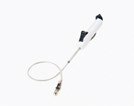Internationally-Renowned Cardiothoracic Surgeon Dr. Sudhir Srivastava Performs Robotic Cardiac Bypass Surgery Using Revolutionary Anastomosis Device

Webcast October 9, 2008 at 5:00 PM EDT From University of Chicago Medical Center
Redwood City, CA - Cardica, Inc. recently announced the webcast of a robot-assisted, closed-chest coronary artery bypass graft (CABG) procedure performed by internationally-renowned cardiothoracic surgeon Sudhir Srivastava, M.D., of the University of Chicago Medical Center, using Cardica's C-Port Flex-A Anastomosis System. Husam H. Balkhy, M.D., chairman of the Department of Cardiac and Vascular Surgery and head of the robotics program at The Wisconsin Heart Hospital, moderates the procedure and explains critical aspects of the surgery. The 75-minute webcast of this minimally-invasive surgery can be viewed on OR-Live.
During the procedure, Dr. Srivastava used Intuitive Surgical's da Vinci Surgical System robot in combination with Cardica's C-Port Flex-A system, an automated device that deploys tiny, stainless steel staples to attach the bypass vessel graft to the coronary artery, a connection known as an anastomosis. By automating the attachment of blood vessel grafts, the C-Port Flex-A system replaces traditional hand-sewn sutures. The robotic CABG procedure was performed off-pump, meaning while the heart is still beating, without the need to use a heart-lung machine and without the need to create a sternotomy, which splits the breastbone (sternum) to gain access to the heart.
Dr. Srivastava performed the surgery on a 79-year-old male patient with 2-vessel coronary artery disease to his left anterior descending and obtuse marginal coronary arteries. Following the surgery, the patient did extremely well and resumed his routine activities within two weeks.
"Robotic, closed-chest, off-pump CABG surgery generally provides numerous patient benefits, including quicker surgery, a shorter hospital stay, less scarring, significantly faster recovery and return to everyday activity, and reduced risk of complications," said Dr. Srivastava, director of robotic and minimally-invasive cardiac surgery at The University of Chicago Medical Center. "Because the C-Port Flex-A system helps facilitate robotic minimally-invasive cardiac surgery, I expect more cardiac surgeons to adopt minimally-invasive CABG procedures."
To date, Dr. Srivastava has completed 34 anastomoses in single and multi-vessel beating heart da Vinci revascularization procedures using the C-Port Flex-A system through small incisions in the chest cavity that create finger-size ports. Of 32 grafts studied, all were determined to be patent, or open, based on an analysis of pre-discharge angiography.
"I believe the C-Port Flex-A system represents a breakthrough in distal anastomosis devices. It facilitates and simplifies robotic CABG procedures, thereby allowing more surgeons to offer patients minimally-invasive cardiac surgery," said Dr. Balkhy. "Because the C-Port Flex-A system can be used to create anastomoses on a beating heart, the patient may not need cardiopulmonary bypass or cardioplegic arrest of the heart, which can be associated with adverse outcomes."
The C-Port System Advantage
Cardica's C-Port systems are designed to enable automated, reliable and reproducible connections of blood vessels during CABG surgery. Unlike most hand-sewn anastomoses, Cardica's C-Port systems enable a compliant anastomosis that can expand and contract with blood flow. The C-Port Flex-A system is designed to deploy staples around the periphery of the anastomosis to help provide leak-proof sealing without the need for additional stitches at either end of the anastomosis. It can be used in either on- or off-pump CABG procedures. The C-Port Flex-A system has a flexible, rather than rigid, shaft and is designed to create compliant anastomoses in vessels as small as 1 millimeter in internal diameter. Importantly, the flexible shaft is designed to allow surgeons to position the device to create a secure connection even in difficult to reach areas of the heart.
About Intuitive's Products
The da Vinci Surgical System consists of a surgeon's viewing and control console having an integrated, high-performance InSite 3-D vision system, a patient-side cart consisting of three or four robotic arms that position and precisely maneuver endoscopic instruments and an endoscope, and a variety of articulating EndoWrist Instruments. By integrating computer-enhanced technology with surgeons' technical skills, Intuitive believes that its system enables surgeons to perform better surgery in a manner never before experienced. The da Vinci Surgical System seamlessly and directly translates the surgeon's natural hand, wrist and finger movements on instrument controls at the surgeon's console outside the patient's body into corresponding micro-movements of the instrument tips positioned inside the patient through small puncture incisions, or ports.
View a preview for this program and learn more by visiting OR-Live
VNR: Cardiac Bypass Surgery
Video-Link Available: http://www2.marketwire.com/mw/frame_mw?attachid=843515
SOURCE: OR-Live, Inc.
